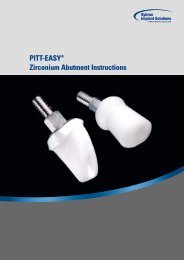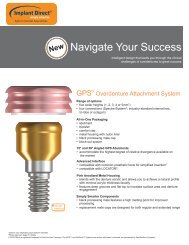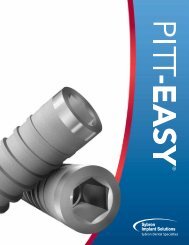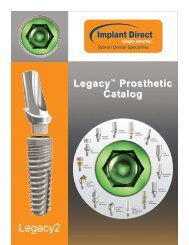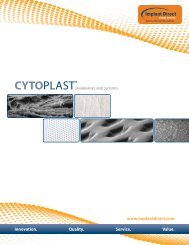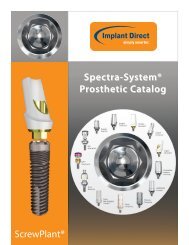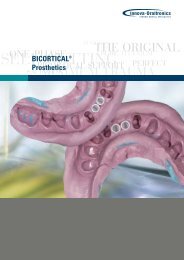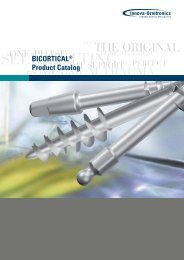The Bicortical Implant for immediate insertion after ... - Implant Direct
The Bicortical Implant for immediate insertion after ... - Implant Direct
The Bicortical Implant for immediate insertion after ... - Implant Direct
You also want an ePaper? Increase the reach of your titles
YUMPU automatically turns print PDFs into web optimized ePapers that Google loves.
Legal notice<br />
<strong>The</strong> implant must be used only by<br />
doctors who are suitably familiar with<br />
the system. <strong>The</strong> instructions (in this<br />
brochure and in the instructions <strong>for</strong><br />
use) must be strictly complied with.<br />
Continuing training in this implant<br />
system is absolutely essential. We<br />
reserve the right to modify or improve<br />
the products in line with technical<br />
progress.<br />
Indication<br />
Ø 2.5 mm<br />
BICORTICAL ®<br />
Basic use as temporary implant, to support and protect the<br />
primary implants during the healing phase. Do not use <strong>for</strong><br />
<strong>immediate</strong> post extraction. A .5 mm diameter of mm<br />
<strong>insertion</strong> depth can remain as final implant if well integrated<br />
in a small interdental space in cortical bone (D1/D ) with<br />
bicortical support. Splinting with other implants or natural<br />
teeth is imperative.<br />
Ø 3.5 mm<br />
For the lateral incisor region in the maxilla, or the central and<br />
lateral incisor in the mandible, also <strong>immediate</strong> post-extraction<br />
with transapical anchorage or bicortical support.<br />
Ø 4.5 mm<br />
For single tooth replacement or bridge abutments in the maxilla<br />
and mandible anterior, canine or presinus regions. Especially<br />
<strong>for</strong> <strong>immediate</strong> post-extraction in these regions in both jaws,<br />
also in connection with other implants or natural teeth.<br />
Ø 5.5 mm<br />
Immediate post-extraction or <strong>after</strong> healing of sockets in mandibular<br />
or maxillary bicuspid region. Special indication of 1 mm<br />
<strong>insertion</strong> depth <strong>for</strong> distal support in the maxillary tuber region,<br />
and funnel-shaped periodontal defects. Can be applied in rich<br />
marrow spongeous bone. Not suitable <strong>for</strong> cortical bone regions.<br />
Histology: Sarnachiaro, Bonal et al., Primates Research Institute,<br />
University of Buenos Aires, “Oral <strong>Implant</strong>ology” 1 /1986.<br />
<strong>The</strong> <strong>Bicortical</strong> <strong>Implant</strong> achieves optimal<br />
bone-implant contact: Osseointegration.<br />
1. implant body<br />
2. original bone, cancellous<br />
3. fatty bone marrow,<br />
not near the implant<br />
4. new bone <strong>for</strong>mation in<br />
direct contact to implant<br />
5. direct bone contact to helix,<br />
no fibrous tissue layer<br />
6. direct bone contact<br />
to implant shaft



